Porcelain Insulator News
by Jack H. Tod
Reprinted from "INSULATORS - Crown Jewels of the Wire", February 1976, page 36
This month we are featuring the "super-threadless" U-988 shown
below. A small cache of these were finally tracked down last fall, and they are
now for sale to collectors by several commissioned dealers.
This porcelain "slash top" threadless is very similar to the glass
counterpart CD-788, and these were said to have been used on Confederate
telegraph lines daring the Civil War. The porcelain one is shown actual size
below, and it is considerably smaller than the glass one.
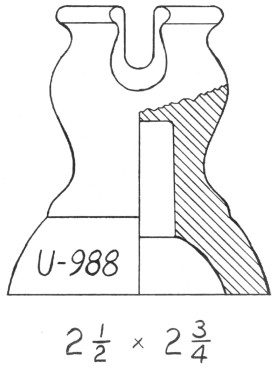
Steve Freedom (Florida) has been a prominent insulator collector for a long
time, and he keeps a few unusual insulators on his office desk as paperweights.
No need to tell you he asks his employees to watch for any unusual insulators
when they are travelling the country servicing the insurance accounts.
One day an agent mentioned seeing one of these funny-looking insulators on a
window sill along with a bunch of nothingless modern insulators. This was in
Georgia. You can imagine how the office work suffered for the next six months
while Steve worried over how to get these animals!
The owners were collectors of general trivia and things old but were not
insulator collectors. They had found these while out scrounging for other items
-- just kicking them up out of the leaves along what must have been the route of
a Confederate telegraph line.
As happens many times, the owners were busy business people with no immediate
financial problems, and Steve had quite a time trying to figure out how best to
liberate the specimens into insulator collecting circles. Before it was over,
enough of a stir was created that he was in danger of a local antique shop
beating his time.
In any event, after three trips to Georgia, numerous phone calls and
considerable financial inducement, Steve ended up with all the specimens that
were found. He took them to the Winter Haven, Fla. show (Nov 15-17), and they
were a sensation. Several collectors in attendance there purchased specimens for
their collections, and Steve commissioned 3 dealers (Riesselman, Venenziano,
Willett) to sell the remaining available specimens.
Because of the importance of this insulator (its very early manufacture,
rarity, historical significance), the National Insulator Association asked me to
obtain one or more specimens for the purpose of authentication and to make a
drawing of it for inclusion in the porcelain Universal Style Chart for positive
reference.
Jack Riesselman (Nebraska) and Dee Willett (Calif.) each sent one specimen to
me for this purpose, and we are indebted to them for their assistance.
Additionally, Steve Freedman furnished information regarding the minor variances
among specimens in the entire group.
These insulators have a white glaze, a shiny white but rather blanche, as
with old porcelain door knobs. They were fired upright on the skirt rim, and the
firing surface was prepared by fettling off the unwanted glaze slip, most
probably with a canvas or coarse rag.
The body material is a very good quality clay -- possibly as good as pure
"Kaolin', china clay. (Note per May 1973 CJ, page 9, there is a reference
in a 1939 American Ceramic Society article to a pottery in Kaolin, S.C. having
made porcelain and pottery insulators for the Confederate telegraph lines.)
Whereas the glass CD-788 was made in a three-part mold with a vertical mold
line in a plane parallel with the slash top, the porcelain U-988 was made in a
two-part forming mold with the mold line in a plane perpendicular with the
slash. The mold line runs from one rim all the way up over the insulator to the
opposite rim as is customary in such porcelain forming molds.
The insulator was made of plastic (wet process) clay being forced into the
forming mold. The pin hole and the bottom resessment were made by plunging a
semi-integral forming tool into the clay while it was in the forming mold. The
pin hole and bottom recess are axially aligned with each other, but there is
improper alignment with the axis of the insulator body, and this varies from one
specimen to another (each being hand plunged).
The actual pin hole depth from top of the pin hole to the "collar"
point varies on specimen, indicating the bottom plunging device was either a
two-part assembly or that more than one plunger was used for this purpose. The
U-988 drawing shows the average pin hole and recessment.
Although very well made for the purpose intended, and considerably better
made than "pottery" threadless insulators of that era, there are the
expected signs of crudeness consistent with the handwork involved in their
manufacture. Besides the misalignment of pin holes on some, the bases vary as to
roundness, and one specimen I inspected sat on the table at a slight tilt due to
an unevenness of the base height.
Although probably not affecting their insulating properties for telegraph
lines, an imperfect pugging of the plastic clay and pressing it into the forming
mold resulted in minor fissures in the body at the rim base. "Dirt"
impossible to clean from these fissures indicates the specimen were found lying
in a red clay soil type. One specimen I inspected had small residual rust stains
from a top conductor and also from a tie wire around the side groove just below
the top "ears".
The pin hole is a small 5/8", and I understand it is typical for both
glass and porcelain threadless insulators to have pin holes varying from tiny to
very large (note the threadless specimen in Nov 1975 CJ, page 33).
The porcelain Slash Top and the Teapot fit the porcelain style chart in the
987 to 995 area. Since the glass Slash Top and glass Teapot are CD-788 and
CD-790 respectively, I've assigned U-988 to the porcelain Slash Top to avoid
confusion, and U-990 is similarly reserved for the porcelain Teapot if someone
will ever send data (shadow profile and dimensions) so we can draw it up.
The U-988 is a cute little insulator, an unusual design with a glass
counterpart, and it has indisputable historical significance. By choice, I do
not collect any threadless insulators, but if I did, I think I would really
"chase" this one.
Jack
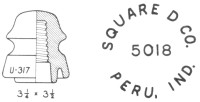
Lew Hohn (Rochester, NY) recently obtained a U-317 which has a crown marking
newly reported for Square-D Company, as shown at right. The "5018"
number in place of the recess-embossed Square-D trademark is undoubtedly the
Square-D Co. catalog number for this item. The U-317 with the ordinary crown
marking is an uncommon item itself, so this new one must rate as a TUF marking.
Fred Locke fans please note. Marking #4-3 was given one way in the April 1975
issue, page 29 (left below) and then corrected and completed in the October 1975
issue, page 24 (right below):

Elton Gish (Texas) recently advised the top lines of marking 4-3 were very
clear and unmistakable on his specimen. Paul Mohrs (Ind.) likewise said the 4-3a
marking was clear on his specimen.
Elton thinks there are two distinct stamps, similar but yet different, and I
have to agree with that. This is also true of other Fred Locke stamps. Either
there were more than one of certain stamps or they occasionally reset the type
in them -- all as related in the October issue.
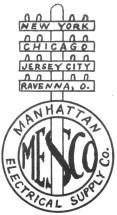
When Roger Pribbenow suggested the magazine cover change whereby the
"T" became a pole with crossarms, Dora told me she thought this was
very clever. Well, I'll certainly agree it's half clever -- at least when
compared with the M.E.S.Co. trademark shown here (registered #71,260, Nov. 10,
1908). Note twice as many crossarms and twice as many insulators per arm in the
trademark.
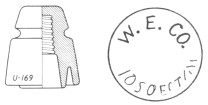
Emma Almeida (Mass.) has an uncanny knack for coming up with great finds --
and also the energy (& stamp) to report them so the rest of us will know of
them.
She just wrote about getting a U-169 which has a W. E. CO. marking in the top
of the pin hole! Other than a pony style with a "5" marking in the pin
hole, this is the first U. S. pin type with any such pin hole marking ever to be
reported.
A wild guess is that the marking is for Western Electric Co., and it could
have been that they had a requirement for some insulators with a pin hole
slightly different from standard. The manufacturer could have marked the end of
a special threading mandrel for this use, and the illegible characters in the
bottom part of the marking on this specimen could have been the factory drawing
number for the special mandrel. If other collectors will inspect the
"haystack" styles they have, we may find one with a completely legible
marking.
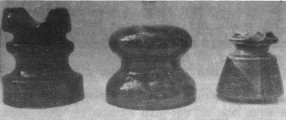
Paul Mohrs (Indiana) sent this photo of three rare items in his collection
and which many collectors may not have seen before.
The one on the left in a U-408, No. 5 Cable, and these were cataloged by New
Lexington in the 1910 era.
The center one is the rare Etheridge patent insulator, U-376A (see Nov. 1974
CJ, page 19).
The one on the right is a U-939C, a rare Fred M. Locke style (also Nov. 1974
CJ, page 19).

Ed Allandar (Penna.) reported in the July 1975 collector survey that he had a
Hi-Top insulator in green, and he just sent me one of these green U-784A on a
trade. This has the Locke Insulator Corp. marking (1943-1962), and cobalt blues
are also known by Locke, Both are scarce, and I know of no other company that
made Hi-Top styles in anything other than brown, white or sky.
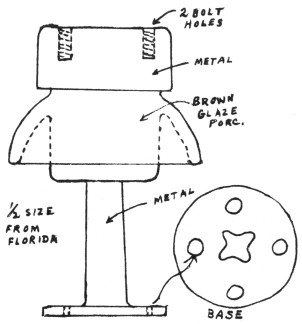
A "whatsit" in the Paul Colburn collection (Florida). Probably a
busbar holder-maybe a third rail insulated holder. Submitted by Gerald Brown.
(It may be a "whatsit" to some, but to me it looks like an ordinary
Switch & Bus insulator. Jack)
LOCKE TWO SPOUTER
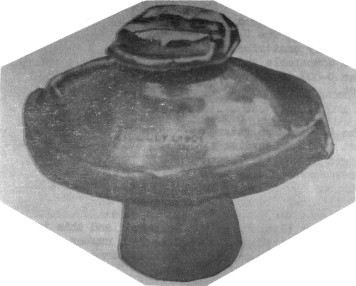
Locke Tan Bell-7-1/2" Ht. 6-1/2"
Gerald Brown's collection
Are there any more of these in collections? The date (July 1. 1901 is manf.
date.)
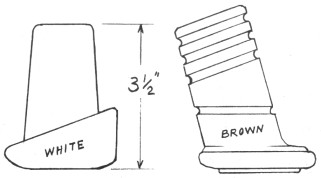
Fay and Everett Moyer (Calif.) sent sketches of 2 porcelain insulators and
wanted to know what they are,
These are bushings used for entering wires in all sorts of equipment such as
transformers. There are literally many thousands of different types of these
things as cranked out by porcelain companies for the past 75 years, and I would
guess there are well over 1,000 of such specialized "insulators" which
are current production items for just poleline hardware companies alone.
Collectors may save these if they just find them lying around, but generally
porcelain items which are only parts of various electrical equipment are out of
the realm of "insulators" as we collect them.
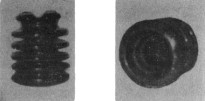
Randy Puchalski (ILL.) sent this photo of a U-807A and which has a Thomas
marking. The U-807A was formerly unattributed. The comparable and similar U-807
is a Lapp product.

The U-601 is an interesting U.S. item in that it is a Canadian style, but it
was cataloged by General Porcelain Co. in 1923. I've never seen one by G.P. Co.
in any collections and had none reported thus far.
Ed Allandar (Penn&.) recently reported that he has a U- 601 with the
"P.M." datestamp marking (Pittsburg High Voltage), and this is
interesting since Pittsburg did make a great number of the insulators used by
Canadian companies., some of which were unique styles used only in Canada.
| 